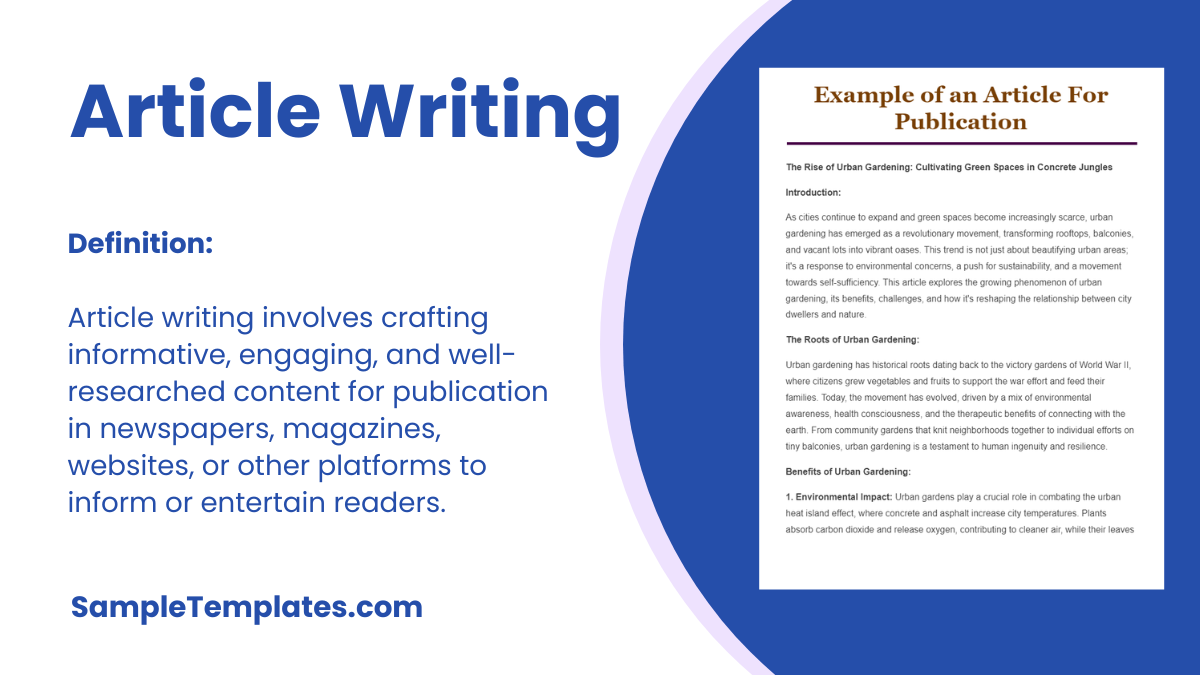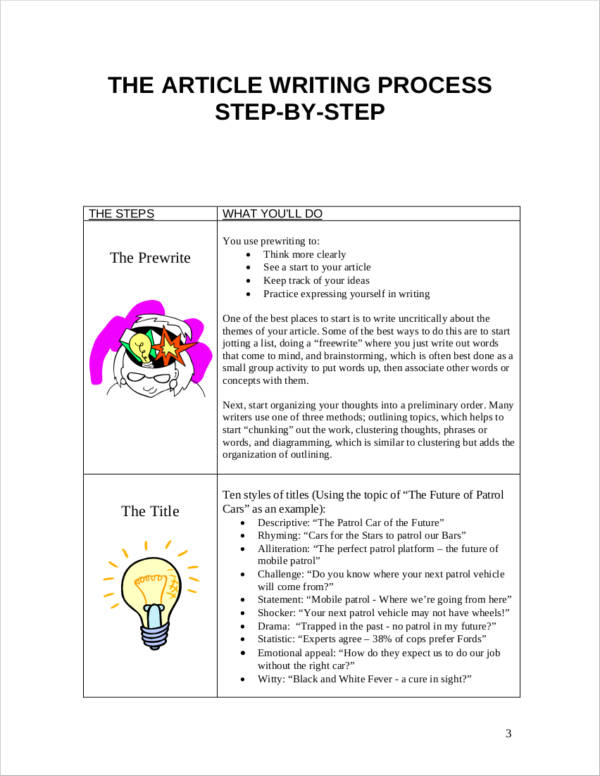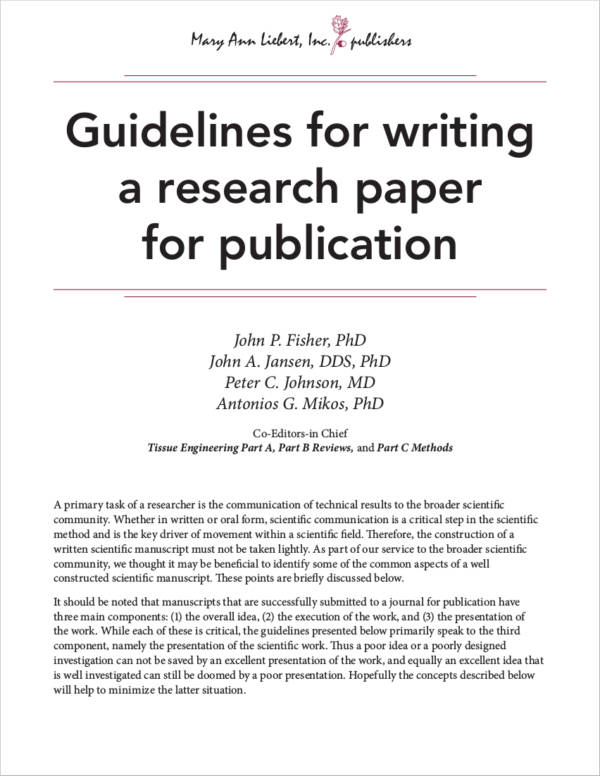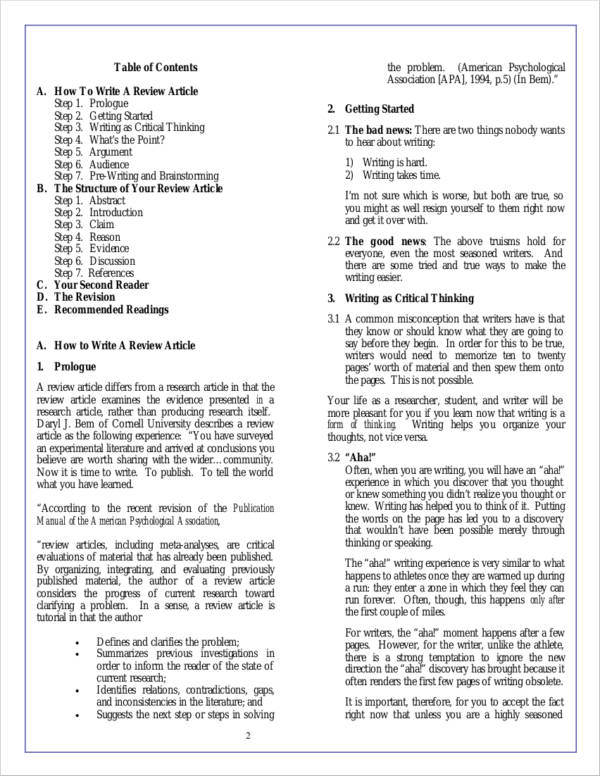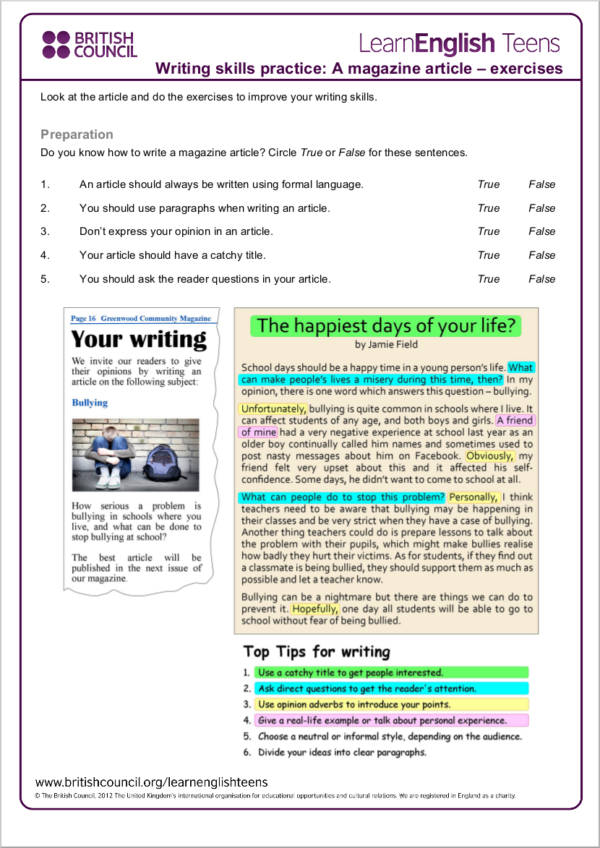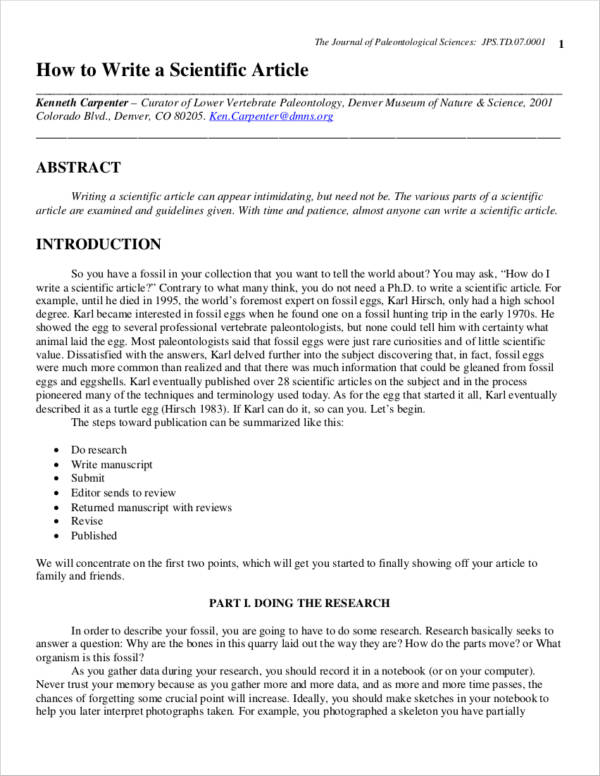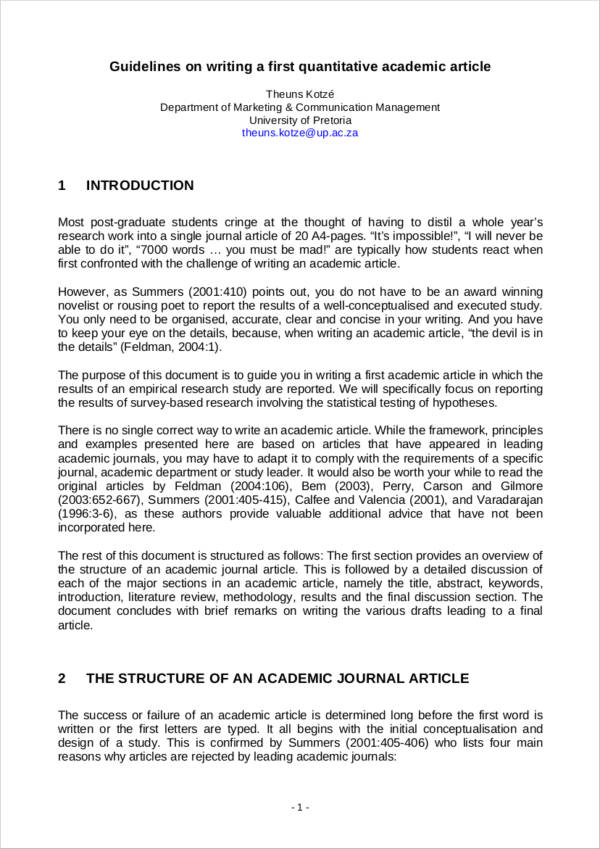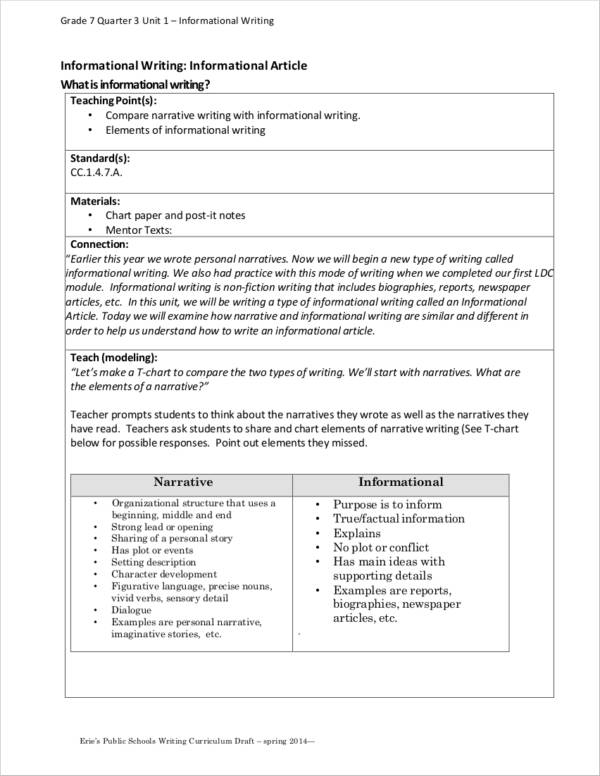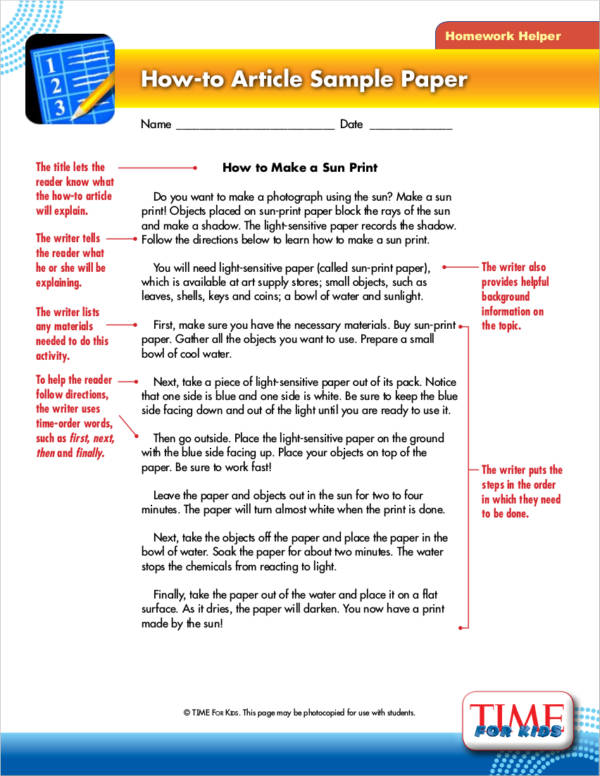Since there are different types of articles, each has unique qualities to it but they still have common qualities and characteristics to them. In general, the approach to writing an article falls under the common qualities and characteristics of different kinds of article. You may also see book writing samples.
In this article, we would like to share with you the most common and efficient way of writing articles—whatever type they may be. Plus, we would also like to share a few free writing samples and guidelines for writing your articles. Just make sure that you keep reading this article to find out more about our topic today. Let’s go!
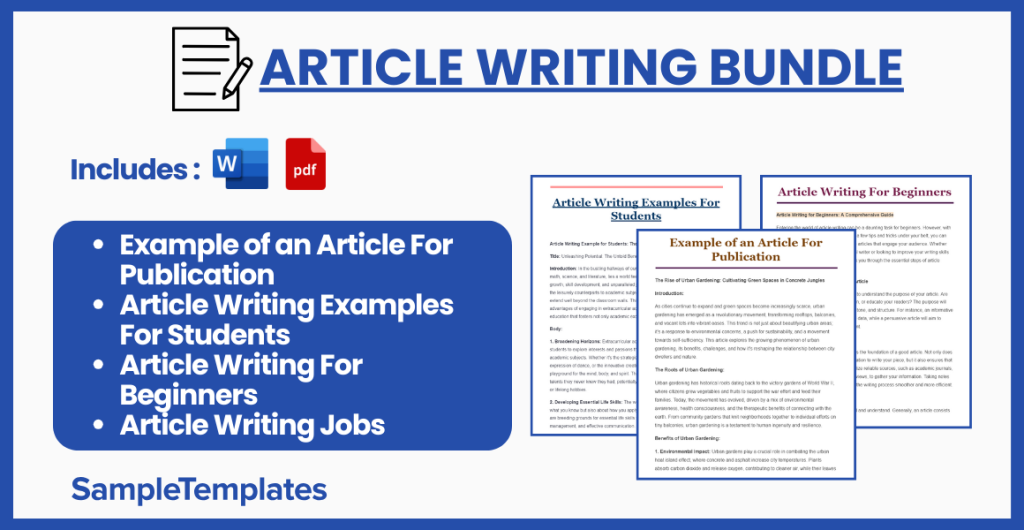
Download Article Writing Bundle
Article Writing Jobs
Navigating the World of Article Writing Jobs: Opportunities and Insights
In the digital age, content is king. This truth has paved the way for a surge in demand for skilled writers capable of crafting compelling articles that engage, inform, and persuade readers. Article writing jobs are plentiful, and they come in various forms, catering to a wide range of interests and expertise. This article delves into the opportunities available in article writing, offering insights for both budding and experienced writers looking to carve out a niche in this dynamic field.
The Landscape of Article Writing Jobs
Article writing is not a monolith but a mosaic of opportunities. Writers can find work in niches ranging from technology, health, and finance to lifestyle, entertainment, and beyond. The diversity in topics means that there’s something for everyone, whether you’re a tech enthusiast keen on the latest gadgets or a health expert wanting to share wellness tips.
Freelance Writing
The freelance market is a significant cornerstone of article writing jobs. Platforms like Upwork, Freelancer, and Fiverr serve as bustling marketplaces where writers can connect with clients needing content. Freelancing offers flexibility, allowing writers to choose projects that align with their interests and schedules. However, it also requires discipline and a proactive approach to secure continuous work and build a portfolio.
Content Mills
Content mills are websites that produce a large volume of content for clients, typically at lower pay rates for writers. While they are often criticized for their pay scales, they can be a viable starting point for new writers looking to gain experience and build a portfolio. Sites like Textbroker and iWriter offer a steady stream of work for those willing to navigate their way through.
Blogging
Blogging remains a steadfast pillar in the realm of article writing. Whether contributing to existing blogs or starting your own, blogging allows writers to delve deep into subjects they’re passionate about. Monetization through advertising, sponsored content, or affiliate marketing can turn a passion project into a profitable venture.
Corporate Writing
Businesses and organizations frequently need quality content to communicate with their customers and stakeholders. This need creates opportunities for writers skilled in crafting newsletters, white papers, annual reports, and web content. Corporate writing jobs often offer stability and higher pay, making them a coveted option for many.
The Importance of Specialization
In a crowded market, specialization can be a key differentiator. Writers who possess in-depth knowledge in specific niches can position themselves as experts, commanding higher rates and attracting clients looking for authoritative content. Whether through formal education, professional experience, or personal passion, developing expertise in a niche can significantly enhance a writer’s career prospects.
Building a Successful Career
Success in article writing requires more than just writing skills. Understanding SEO, mastering the art of pitching, and building a strong online presence can greatly increase visibility and opportunities. Networking, continuous learning, and adapting to changing content trends are also crucial for long-term success.
Conclusion
The world of article writing jobs is rich with opportunities for those willing to explore, specialize, and continuously hone their craft. Whether starting as a freelancer, contributing to content mills, blogging, or entering the corporate world, the paths are as varied as they are rewarding. With dedication and strategy, article writing can be more than just a job; it can be a fulfilling career that keeps pace with the ever-evolving landscape of digital content.
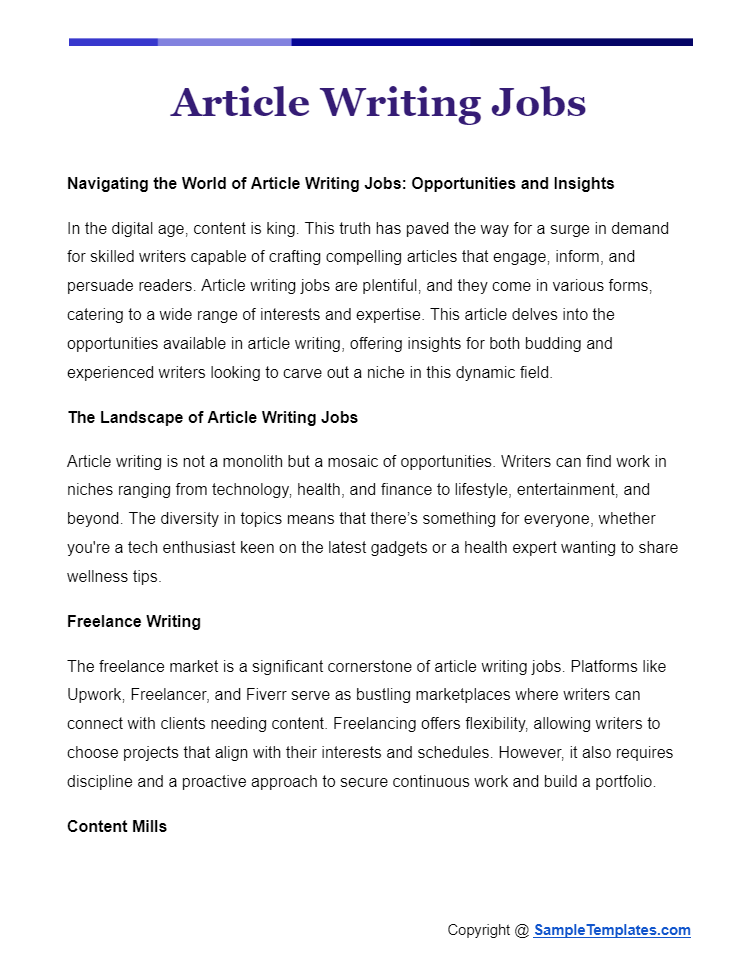
Article Writing For Beginners
Article Writing for Beginners: A Comprehensive Guide
Entering the world of article writing can be a daunting task for beginners. However, with a clear understanding of the basics and a few tips and tricks under your belt, you can start crafting compelling and informative articles that engage your audience. Whether you’re aspiring to become a professional writer or looking to improve your writing skills for personal projects, this guide will walk you through the essential steps of article writing for beginners.
Understanding the Purpose of Your Article
Before you start typing away, it’s crucial to understand the purpose of your article. Are you aiming to inform, persuade, entertain, or educate your readers? The purpose will significantly influence your writing style, tone, and structure. For instance, an informative article will focus on presenting facts and data, while a persuasive article will aim to convince readers of a particular viewpoint.
Research is Key
No matter the topic, thorough research is the foundation of a good article. Not only does it provide you with the necessary information to write your piece, but it also ensures that your article is accurate and credible. Utilize reliable sources, such as academic journals, reputable news outlets, and expert interviews, to gather your information. Taking notes and organizing your research will make the writing process smoother and more efficient.
Structuring Your Article
A well-structured article is easier to read and understand. Generally, an article consists of:
- Introduction: Grab your readers’ attention with a hook, provide background information on your topic, and present the main idea or thesis statement of your article.
- Body: This is where you delve into the details. Organize the body into sections or paragraphs, each focusing on a specific point or aspect of your topic. Use headings and subheadings to break up the text and guide readers through your article.
- Conclusion: Summarize the key points made in your article and restate the main idea. Depending on your article’s purpose, you may also encourage action, pose a thought-provoking question, or reflect on the implications of your topic.
Writing Style and Tone
The tone of your article should align with your audience and purpose. A formal tone is suitable for academic or professional articles, while a more conversational tone works well for blogs and lifestyle pieces. Regardless of the tone, clarity and conciseness are your best friends. Avoid jargon and complex sentences that might confuse your readers. Instead, aim for clear, straightforward language that conveys your message effectively.
Editing and Proofreading
The first draft is just the beginning. Editing and proofreading are critical steps in the article writing process. Look for ways to improve the flow and coherence of your article, check for factual accuracy, and make sure your arguments are logical and well-supported. Pay attention to grammar, punctuation, and spelling errors that could detract from your article’s professionalism.
Practice Makes Perfect
Like any skill, writing improves with practice. Don’t be discouraged by initial challenges or criticism. Use feedback constructively to hone your craft. Write regularly, experiment with different styles and formats, and read widely to gain inspiration and learn from other writers.
Conclusion
Article writing for beginners may seem challenging at first, but by understanding your purpose, conducting thorough research, structuring your article effectively, and refining your writing style and tone, you can create engaging and impactful articles. Remember, the journey to becoming a skilled writer is a process of continuous learning and practice. Embrace it, and you’ll find your voice and place in the vast world of writing.
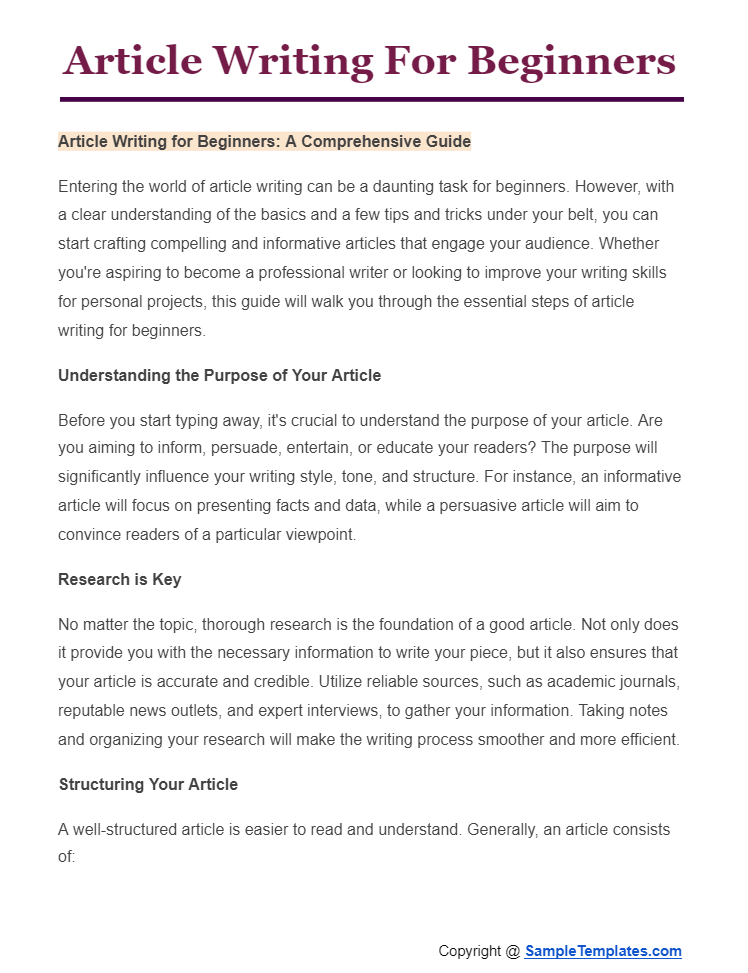
Article Writing Examples For Students
Article Writing Example for Students: The Benefits of Extracurricular Activities
Title: Unleashing Potential: The Untold Benefits of Extracurricular Activities
Introduction: In the bustling hallways of our schools, beyond the rigorous schedules of math, science, and literature, lies a world teeming with opportunities for personal growth, skill development, and unparalleled joy. Extracurricular activities, often seen as the leisurely counterparts to academic subjects, hold profound benefits for students that extend well beyond the classroom walls. This article delves into the multifaceted advantages of engaging in extracurricular activities, advocating for a well-rounded education that fosters not only academic excellence but also holistic development.
Body:
1. Broadening Horizons: Extracurricular activities provide a unique platform for students to explore interests and passions that are not typically covered in traditional academic subjects. Whether it’s the strategic complexities of chess, the disciplined expression of dance, or the innovative creations in robotics clubs, these activities offer a playground for the mind, body, and spirit. They enable students to discover and nurture talents they never knew they had, potentially guiding them towards future career paths or lifelong hobbies.
2. Developing Essential Life Skills: The world outside school gates is not just about what you know but also about how you apply that knowledge. Extracurricular activities are breeding grounds for essential life skills such as teamwork, leadership, time management, and effective communication. Participating in sports teams, for example, teaches students about collaboration, perseverance, and dealing with defeat gracefully. Leadership roles in clubs or societies foster responsibility, initiative, and the ability to motivate others. These are invaluable skills that prepare students for the complexities of adult life and the professional world.
3. Enhancing Academic Performance: Contrary to the belief that extracurricular activities distract from academic work, research suggests that students who engage in these activities tend to have better academic outcomes. This correlation can be attributed to improved time management skills, increased motivation, and the application of various soft skills learned through extracurricular involvement to academic pursuits. Moreover, the sense of accomplishment and confidence gained from these activities can boost students’ self-esteem, positively impacting their academic performance.
4. Fostering Social Connections: Extracurricular activities create a sense of community and belonging among participants. They connect students from diverse backgrounds with common interests, building friendships that can last a lifetime. These social networks provide emotional support, reduce feelings of isolation, and enhance students’ overall well-being. In addition, the collaborative nature of many extracurricular activities encourages empathy, understanding, and respect for others’ perspectives and abilities.
Conclusion: Extracurricular activities are not mere pastimes but essential components of a comprehensive education system. They equip students with practical skills, foster personal growth, and enrich the educational experience in immeasurable ways. As educators, parents, and policymakers, it is our collective responsibility to ensure that students have access to a wide range of extracurricular options. By encouraging and supporting their participation, we unlock the door to developing well-rounded individuals ready to face the world’s challenges with confidence and creativity.
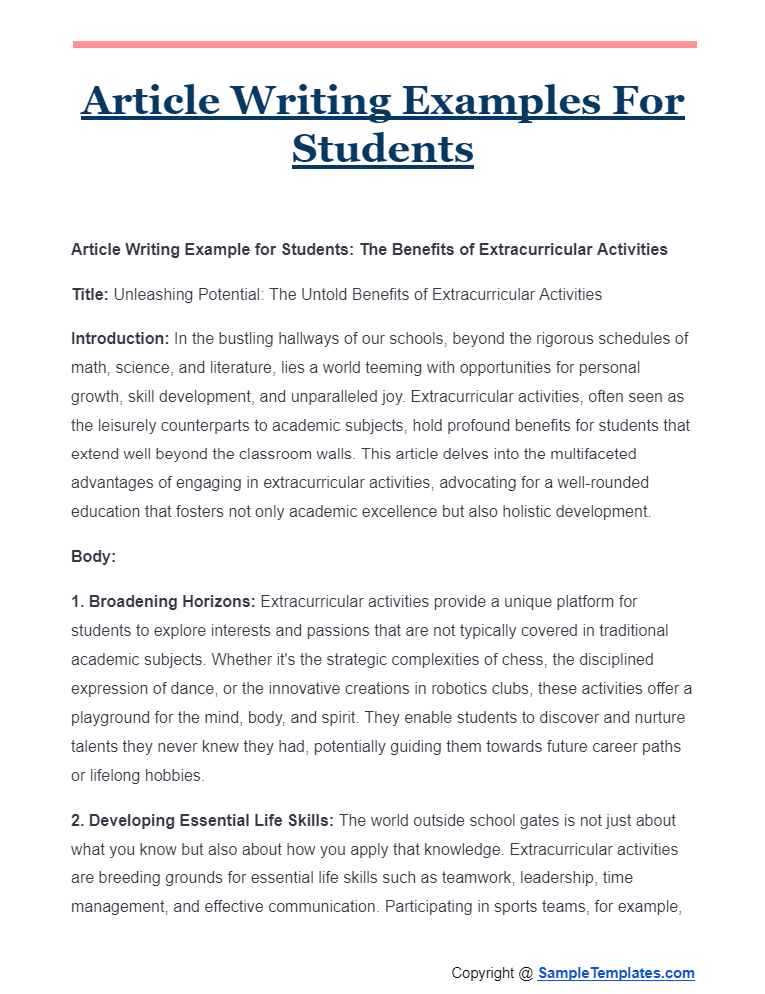
Example of an Article For Publication
The Rise of Urban Gardening: Cultivating Green Spaces in Concrete Jungles
Introduction:
As cities continue to expand and green spaces become increasingly scarce, urban gardening has emerged as a revolutionary movement, transforming rooftops, balconies, and vacant lots into vibrant oases. This trend is not just about beautifying urban areas; it’s a response to environmental concerns, a push for sustainability, and a movement towards self-sufficiency. This article explores the growing phenomenon of urban gardening, its benefits, challenges, and how it’s reshaping the relationship between city dwellers and nature.
The Roots of Urban Gardening:
Urban gardening has historical roots dating back to the victory gardens of World War II, where citizens grew vegetables and fruits to support the war effort and feed their families. Today, the movement has evolved, driven by a mix of environmental awareness, health consciousness, and the therapeutic benefits of connecting with the earth. From community gardens that knit neighborhoods together to individual efforts on tiny balconies, urban gardening is a testament to human ingenuity and resilience.
Benefits of Urban Gardening:
1. Environmental Impact: Urban gardens play a crucial role in combating the urban heat island effect, where concrete and asphalt increase city temperatures. Plants absorb carbon dioxide and release oxygen, contributing to cleaner air, while their leaves provide shade and natural cooling. Moreover, gardening promotes biodiversity, offering habitats for birds, insects, and other wildlife.
2. Health and Well-being: Gardening is not only a physical activity but also a form of mental therapy. It reduces stress, promotes relaxation, and can improve mood. Furthermore, growing one’s food can lead to a healthier diet, with easy access to fresh, organic produce that’s free from harmful pesticides.
3. Social Cohesion: Community gardens foster a sense of belonging and collective responsibility. They become spaces where people of diverse backgrounds come together, share knowledge, and build friendships. These gardens can also be educational hubs, teaching children and adults alike about the importance of sustainability and food security.
Challenges and Solutions:
Despite its many benefits, urban gardening faces challenges such as limited space, soil contamination, and water access. Innovative solutions, like vertical gardening, hydroponics, and community composting, have emerged to address these issues. Cities are also increasingly recognizing the value of green spaces, leading to policies that support urban agriculture initiatives.
Urban Gardening in Action:
Cities around the globe are embracing urban gardening with remarkable projects. For example, Paris has initiated the “Parisculteurs” project, aiming to cover the city’s rooftops and walls with greenery by 2022. Singapore, known as the “City in a Garden,” integrates green spaces into its urban development plans, boasting sky gardens and the world-renowned Gardens by the Bay.
Conclusion:
Urban gardening is more than a trend; it’s a movement towards a sustainable, healthier, and more connected urban life. By turning towards our rooftops, balconies, and unused spaces, we’re not only reclaiming the green in our cities but also taking important steps towards environmental stewardship and community well-being. As this movement grows, it holds the promise of transforming our urban landscapes into lush, productive, and sustainable ecosystems where nature and humanity thrive together.
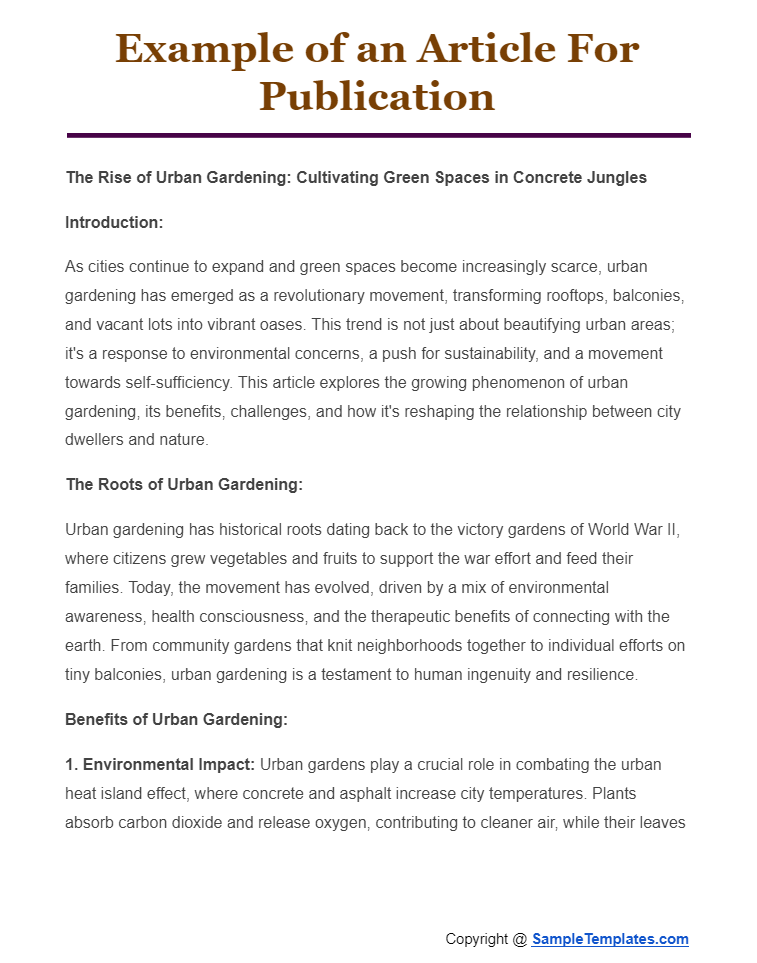
Browse More Templates On Article Writing
Article Writing Samples PDF
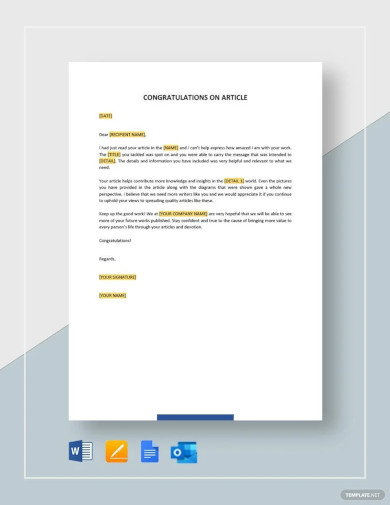
Article Sample
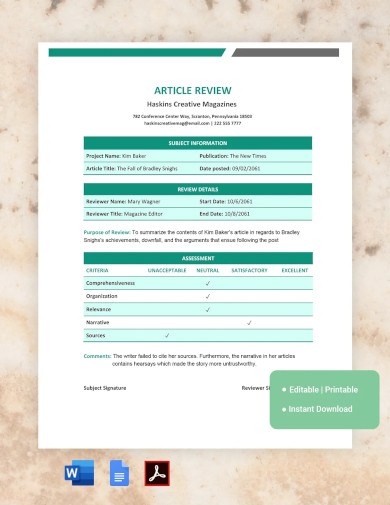
Article Writing Format
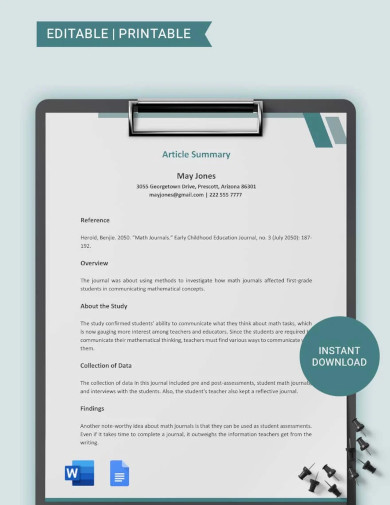
Tips For Writing Articles
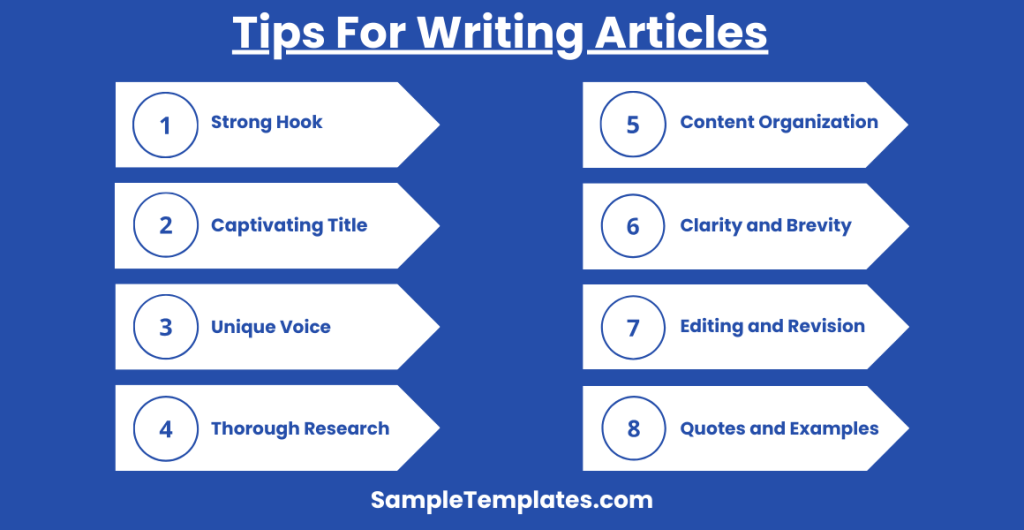
- Know Your Audience: Understand who you’re writing for. Tailor your language, tone, and content to meet their interests and needs. An article for industry professionals, for example, will look different from one aimed at casual readers.
- Choose a Captivating Title: Your title is the first impression readers have of your article. Make it intriguing and clear, giving readers a compelling reason to dive into your piece.
- Start with a Strong Hook: Begin your article with an engaging hook that grabs your readers’ attention. Use a surprising statistic, a thought-provoking question, or a powerful statement to pique interest.
- Do Thorough Research: A well-researched article stands out. Use credible sources to gather information and provide depth to your writing. This not only enhances your credibility but also enriches your content.
- Organize Your Content: A clear structure makes your article easier to follow. Use headings, subheadings, bullet points, and paragraphs to break up text, guide your readers through your arguments, and highlight key points.
- Write Clearly and Concisely: Clarity and brevity are your allies. Avoid jargon and unnecessarily complex sentences. The goal is to convey your message as simply and effectively as possible.
- Incorporate Your Unique Voice: Let your personality shine through your writing. A unique voice can make your article more relatable and memorable. It’s what sets you apart from other writers.
- Use Quotes and Examples: Quotes from experts and real-life examples add authority and illustrate your points more vividly. They can make abstract concepts concrete and relatable.
- Edit and Revise: The first draft is just the beginning. Review your work for grammar, punctuation, and style. Look for ways to improve clarity, coherence, and readability. Editing is a crucial step in refining your article and making it the best it can be.
Short Article Sample
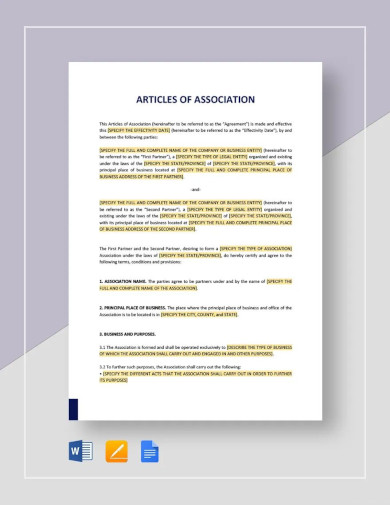
Magazine Article Example
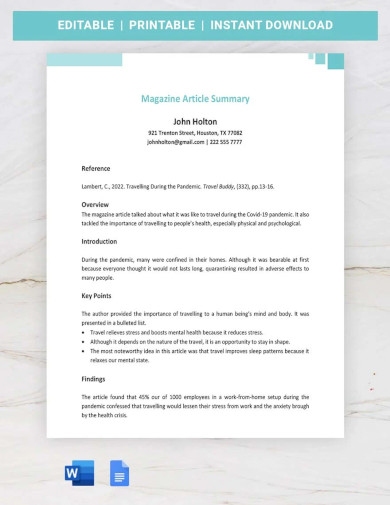
How To Write an Article in 7 Easy Steps
Writing an article can be a straightforward process if you approach it methodically. Here are seven easy steps to guide you through writing an effective and engaging article:
1. Choose Your Topic
Start by selecting a topic that interests you and is relevant to your audience. Consider what your readers might find informative, entertaining, or useful. If you’re writing for a specific publication or website, make sure your topic aligns with their content and style.
2. Do Your Research
Gather all the necessary information about your topic. This might involve reading books, exploring online resources, interviewing experts, or reviewing studies. Ensure your sources are credible and note down all important points and ideas that you might want to include in your article.
3. Create an Outline
Organize your thoughts and research findings by creating an outline. This should include a brief introduction to your topic, the main points or sections of your article, and a conclusion. An outline helps structure your article logically and ensures you cover all necessary aspects.
4. Write the Introduction
Craft an engaging introduction that captures your readers’ attention and outlines what your article will cover. Use a hook, such as a surprising fact, a question, or a compelling statement, to pique interest. Briefly mention the main points you will discuss.
5. Develop the Body
Expand on each point outlined in your introduction, dedicating a section or paragraph to each. Provide detailed information, examples, and analysis to support your points. Make sure each section flows logically into the next, and use subheadings to break up the text and guide readers through your article.
6. Conclude Your Article
Summarize the main points of your article in the conclusion, reinforcing the key takeaways for your readers. You can also encourage further thought or action by posing a question, offering a final insight, or suggesting resources for further reading.
7. Edit and Proofread
Review your article for clarity, coherence, and grammatical accuracy. Check for spelling and punctuation errors, and ensure your writing is concise and free of jargon. It can be helpful to take a break before editing, as coming back with fresh eyes may help you catch errors you previously missed. Additionally, consider asking a peer to review your article for feedback.
By following these seven steps, you can streamline the article writing process, making it less daunting and more efficient. Remember, practice makes perfect, so keep writing and refining your skills with each article you create.
Article Writing Examples
Types of Articles
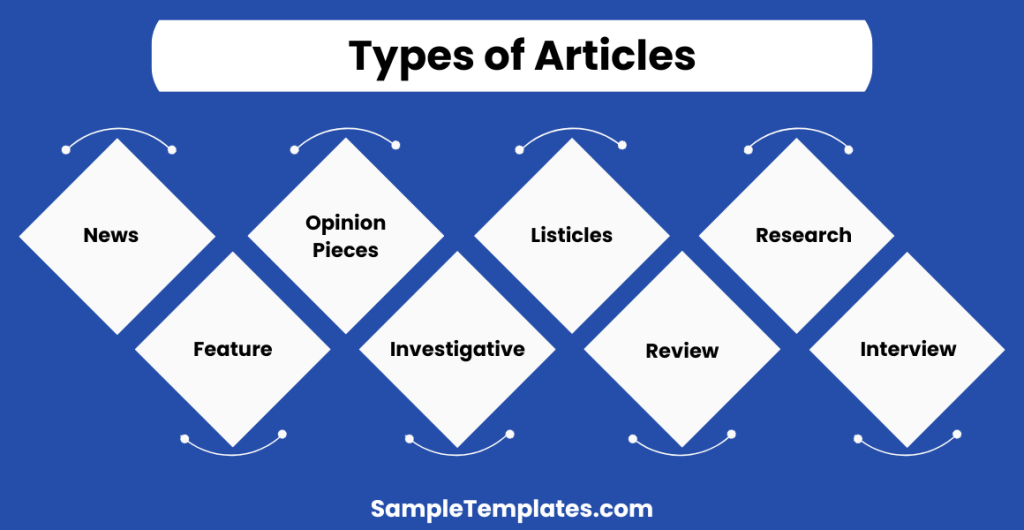
Articles come in various forms, each serving a different purpose and audience. Understanding the types of articles is crucial for writers to tailor their content effectively. Here’s a brief overview of the main types:
- News Articles:
- Focus on current events, breaking news, and updates.
- Emphasize factual reporting and timeliness.
- Aim to inform the public about recent developments.
- Feature Articles:
- Offer in-depth exploration of a topic, person, or event.
- Combine factual reporting with a more narrative style.
- Can include profiles, human-interest stories, and backgrounders on current events.
- Opinion Pieces/Editorials:
- Express the writer’s viewpoint on a specific issue.
- Aim to persuade or influence public opinion.
- Often reflect the editorial stance of the publication.
- How-to Articles:
- Provide step-by-step guidance on completing a task or solving a problem.
- Focus on practical advice and actionable tips.
- Popular in lifestyle, technology, and DIY publications.
- Listicles:
- Present information in a list format, making it easy to scan and read.
- Can cover a wide range of topics, from entertainment to educational content.
- Blend of entertainment and information, often with a casual tone.
- Review Articles:
- Evaluate products, services, or experiences, such as books, movies, or restaurants.
- Offer critical analysis and personal opinions.
- Help readers make informed decisions based on the review.
- Research Articles:
- Present original research findings in a detailed format.
- Include methodology, data analysis, and conclusions.
- Common in academic and scientific journals.
- Interview Articles:
- Feature conversations with experts, celebrities, or other notable individuals.
- Provide insights into the interviewee’s perspectives, experiences, or achievements.
- Can be structured as a Q&A or narratively integrated into the article.
- Investigative Articles:
- Involve in-depth research and reporting to uncover new information on a significant issue.
- Require substantial time and resources to compile evidence and verify facts.
- Aim to inform the public about matters of importance, often leading to change or action.
Each type of article has its unique structure, style, and purpose, catering to specific reader interests and needs. Understanding these distinctions allows writers to craft their messages more effectively and engage their intended audience.
Article Writing PDF Download
Article Sample PDF
Magazine Article Sample PDF
Ideas, Ideas, Ideas!
This is where it all starts. When ideas start pouring, the content of your article becomes more and more interesting. So here are ways on how we can come up with ideas and how we can organize these ideas to form an article that is worth reading. You may also see job application writing samples.
1. Know What Article You Will Be Writing
It would be a great idea to familiarize yourself with what type of article you will be writing. The type of article you will be writing will all depend on your preference or the requirement needed. What are the common types of articles?
- News articles are the types of articles that are based on recent events or events that are about to happen.
- Feature articles are written in an approach that is creative and focuses on people, events, or other subjects that are deemed to be creative. A ton of times, blogs are written in this manner.
- Editorial articles are usually found in sample newspapers. They typically present the opinion of the newspaper on a certain trending issue. These are usually paired with editorial cartoons that best represent the article.
- How-to articles, from the name itself, are articles that are instructional in nature. These articles give you detailed information about how you can do certain tasks.
2. List Down Potential Topics
Make a checklist of topics that you would like to tackle. This will help you narrow down your topic to make it more condensed yet packs a lot of information with every sentence that the reader is reading. By narrowing down your topics, you will remain more focused and be able to avoid being redundant. Plus, it will help you make your sentences as coherent as possible. You can check out List Samples in Excel to get list templates that can help you make a list of topics to discuss.
You have to make sure that when you are writing your article that you are interested in your topic and that you put your heart into it as well. An article written half-heartedly will end up being dull and will also end up not being interesting to the reader as well.
3. Passion
As we have mentioned, it would be great if you are interested in your topic. It will even be better if you are passionate about it as your passion will surely resonate to your articles and make your articles very interesting. You may also see letter writing samples.
If you are passionate about what you are writing, you will surely be able to discuss it efficiently and be able to write a lot of details about it. Your passion will show in the way you write your topic and your audience will definitely be more engaged with what they are reading. You want to give your article the aura that is worth reading about.
4. Research
You may not always be given the chance to write about a topic that you are passionate about. This is especially true if you are asked to write college essays, which is a requirement for certain subjects you may have. However, it does not mean that just because you are not passionate or interested in the topic you are required to write, your writing should also fall short. What you can do to help you gain more knowledge and ideas about what you are going to write about, you should definitely do your research. Even if you are interested in the topic you are writing, doing preliminary research will be of great help especially if there are recent news about the topic chosen. You can conduct research in your local library and through the Internet.
5. Make Your Article Stand Out
Once you have done your research and have listed down the points that you will be focusing on, it is now time to think about how you can approach your article in a way that will make it stand out from the other articles and topics that are similar to yours. You may also like report writing formats.
6. The Argument
A ton of times, you will find an argument in an article which is what makes the article solid. If you are developing an argument for your article, make sure that you base your arguments on facts. Remember that your article will stand out better if you are able to make a good quality argument. To ensure that you stay focused on your argument, you can highlight it or change the font color while you are writing your article to ensure that you will always be reminded of your argument. You may also like summary writing samples.
Do Your Research
Researching your topic can help to make your arguments and topics more solid. It can even take it to a whole new level and open possibilities for more arguments. This is how you can do your research on your topic.
1. Know More about Your Topic
In-depth research about your topic will be a good way of ensuring that you will be able to get all of your facts straight. You can make a simple SWOT analysis about your topic and discuss each item.
You can make use of journals, hearing documentation, sample certificates, and other archives for your primary sources. These can be found in your local library and even in scholarly websites on the Internet. You can also gather some useful information from abstracts, dissertation, reference books and you may even conduct some interviews.
2. Cite Examples
Citing examples to support your argument can help to support your argument and make it more reliable. Make sure that you prioritize which ones are strongest examples.
You should also make sure that you are getting information from reliable sources. You can refer to the reference list to ensure that you have a backup for whatever claims you make in your article.
3. Take Note of Your Sources
You should always make sure that you jot down the sources you have used for your article as you will include these in the annotated bibliography of your article. Take note of the following:
- Title of the source
- Name of author/s
- Year published
- Page number
- Publisher
You can cite these according to your preference or the requirement. It can either be in MLA, APA, and Chicago citation styles.
4. Do Not Plagiarize
Never copy phrases and sentences word for word. Instead, understand the information you have gathered and phrase it in your own words. Take note of how you compose your sample statements and phrases. If in any case there is a need for you to copy everything word by word, place these in quotation marks or paraphrase and make sure to properly cite your source.
Outline
Making an outline before you start writing your letter can actually help you organize your thoughts. Here are a few tips that we would like to share with you regarding making an essay outline.
1. How Long Will Your Article Be?
Think about whether you have to reach a certain amount of word count or a certain number of pages. Different types of articles have different requirements, so always make sure that you refer to the type of article that you are writing. You also have to think about how much you would need to write in order to cover your topic and argument appropriately. You may also like summary writing samples.
2. Get to Know Who Will Read Your Article
Take into account who is going to read your article. Think about the interests, expectations, as well as the reading level of your audience. Always match your tone with that of your audience’s as well as the writing style. Remember that for different types of article, you will have different types of approach.
3. Create an Outline
Make sure that you make a simple outline. This will help you have a good breakdown of the sequence of the details that you will be discussing in your article. It will also help to give you an idea whether or not you need to insert a few more subtopics or details in certain parts of your article.
Start Writing Your Article
Now that you have done all the necessary steps in preparing what you will write, it is now time for you to start writing your article. Here are the steps that you need to undertake once you start writing your article.
1. Catchy Introduction
Writing a catchy introduction letter will help to assure that you will be able to catch your audience’s attention and get them hooked on your article. Your introduction will be used by the audience to gauge whether your write-up is worth the read or otherwise.
In order to make your introductions catchy, you can do the following:
- Start with interesting facts about the topic.
- Insert quotes or anecdotes that are related to your topic.
- Make use of statistics.
2. Follow the Outline
Following what you have drafted in your essay outline can help you stay more focused and you will know what you will need to prioritize. This way, your statements or sentences will make more sense and will end up being coherent with each other as your outline will remind you regarding how each subtopic is connected with each other.
However, you may find that while you are writing your article, you write in a way that does not seem to follow the outline. That is okay. Sometimes, there will come a time where you might need to be flexible and change a few aspects of your article.
3. Give Details
Not everyone who will be reading your article will know what your topic is all about. You have to make sure that you explain everything in detail and provide a description of words that may be considered as jargon.
4. Language, Style, Structure, and Tone
When writing your article, you have to be mindful of the tone you are using when constructing your sentences. You have to make sure that you match it with the audience or target readers. Make sure that you have a good idea of who will be reading your article in order to properly match your writing style, structure, and tone with the audience.
The language that you should use should preferably be one that would be easy to understand but is still formal. It should be able to properly give a good idea of what your article is about as a whole. Make sure that every paragraph gets more and more interesting to ensure that the audience will stay hooked. You may also see resume writing samples.
If you find that your sentences tend to be a bit longer, make sure that you chop it into shorter ones to make it easier to read. This way, you will avoid boring your audience.
5. Use Graphs and Illustrations
There will surely be subtopics that are best represented by graphical illustrations. These will serve as supplemental information that will help the reader to understand your main point better. Plus, it would be great to have these in between texts as it is a good break for your eyes. You may include the following in your article:
- Photographs
- Charts
- Graphs
- Infographics
6. Transition Phrases
Using transition phrases will aid the audience read your article in a smooth manner. This means that the start of each paragraph should contain the transition phrases especially if you are highlighting another point.
7. End Strong
When you start strong, you also have to end strong. This will be the part of the article that will be embedded in the minds of your reader. This is where you reiterate the most important points of your topic and argument. Your conclusion is meant to give a new insight into the topic and encourage the reader to find out more about the topic. You can find out more about writing good conclusions by reading How to Write in an Academic Style.
Final Touches
The final touches will be the one that will help make your article ready for publishing or submission. Here are some of the ways of ensuring that your write-ups are in top-notch form.
- Edit. Editing your work can be such a tiring task but you will definitely thank yourself for doing so. By going through your work, you will be able to determine if your topic and what you have written all make sense and are all relevant. Make sure to eliminate any paragraphs that are unrelated or do not seem to be a good fit for the central argument. Eliminate any information that is also contradictory to your main points. Rewrite any sections if you see it to be necessary. You may also like printable writing paper templates.
- Avoid grammatical errors. Ensuring that your article is free from grammatical errors makes it more polished and professional.
- Read your article. Reading your article aloud will help give you the feels as to how your readers will also read it. By reading it aloud, you will also be able to determine which sections or parts will need a few more edits or rearranging. Reading aloud also helps you determine if your arguments make sense and if your statements are coherent with each other.
- Ask someone else to read the article. Show your article to someone else. By someone else, we mean someone who can definitely help you make appropriate improvements to your article. It can be a friend or a teacher who has experience when it comes to the type of article you have written. Print them a copy and ask them to write a few notes and constructive criticism that can help make the article more solid. You may also like speech writing samples.
Professional Article Example
Academic Article Writing
Informational Article Writing
How-To Article Writing
We hope that you learned a lot about writing your own article. Basically, when you write an article and whatever type of article it may be, you are able to develop your writing and researching skills more. These developments can also help you have better communication skills. As time passes by, you will find yourself getting better and better at writing. you articles will become more aggressive, persuasive, and unique.
Interested in writing news articles? Check out our article about Newspaper Article Samples.
How can I start my article writing?
Begin your article by crafting a compelling introduction that sparks curiosity, poses a thought-provoking question, or shares a captivating anecdote, setting the tone for the reader’s engagement and interest.
What is article writing and format of article writing?
Article writing is creating content to inform, entertain, or persuade. The format typically includes an engaging title, introduction, body paragraphs, and a conclusion, providing valuable information or insights.
What’s in an article?
An article typically comprises well-researched information, a clear introduction, body with supporting details, and a concise conclusion. It communicates insights, educates, or entertains, tailored to the target audience.
Where can I write articles?
You can write articles on various platforms, including blogging websites like WordPress and Medium, content-sharing platforms like LinkedIn, or traditional publishing sites that accept guest contributions.
In conclusion, effective article writing requires thorough research, engaging content, and a clear structure. By adhering to these principles and continuously refining one’s writing skills, authors can create compelling articles that inform, entertain, and resonate with their audience.
Related Posts
-
FREE 8+ Persuasive Writing Samples and Templates in PDF
-
Reflective Writing
-
Abstract Writing Samples and Templates
-
FREE 11+ Scriptwriting Samples and Templates in PDF
-
8+ Price Tag Samples in Illustrator | PSD | Publisher | Apple Pages
-
How to Write a Best User Story: with Samples & Templates
-
FREE 15+ Manufacturing Samples in MS Word | PDF
-
FREE 31+ Announcement Samples in MS Word | PSD | PDF
-
FREE 15+ Photo Booth Samples in MS Word | PSD | PDF
-
FREE 33+ All About Me Samples in PDF
-
FREE 15+ Wedding Vow Samples in PDF
-
FREE 22+ Sales Pipeline Samples in PDF
-
FREE 10+ Bingo Board Samples in PDF
-
FREE 20+ Board Game Samples in PDF
-
FREE 28+ Job Aid Samples in PDF
